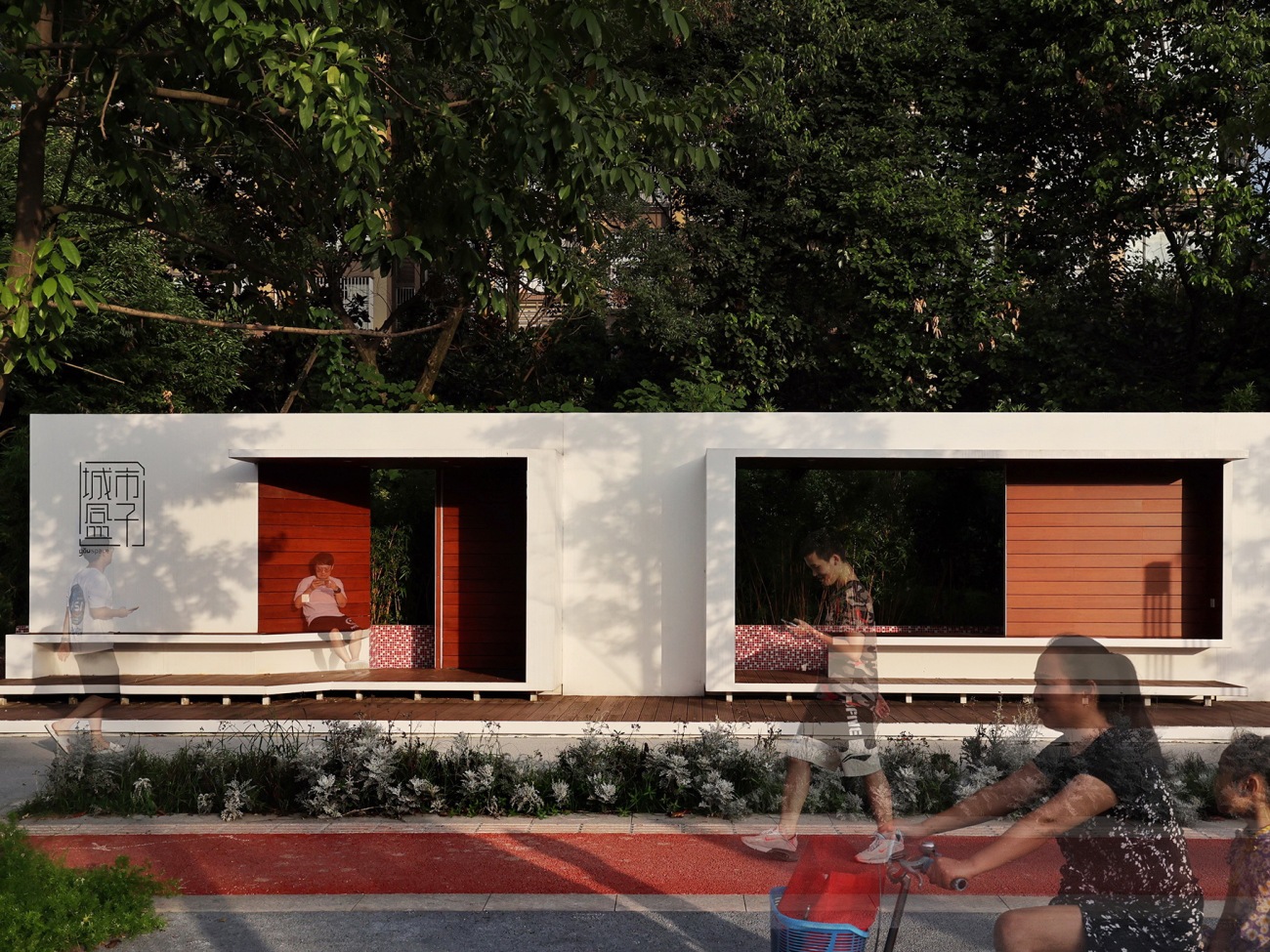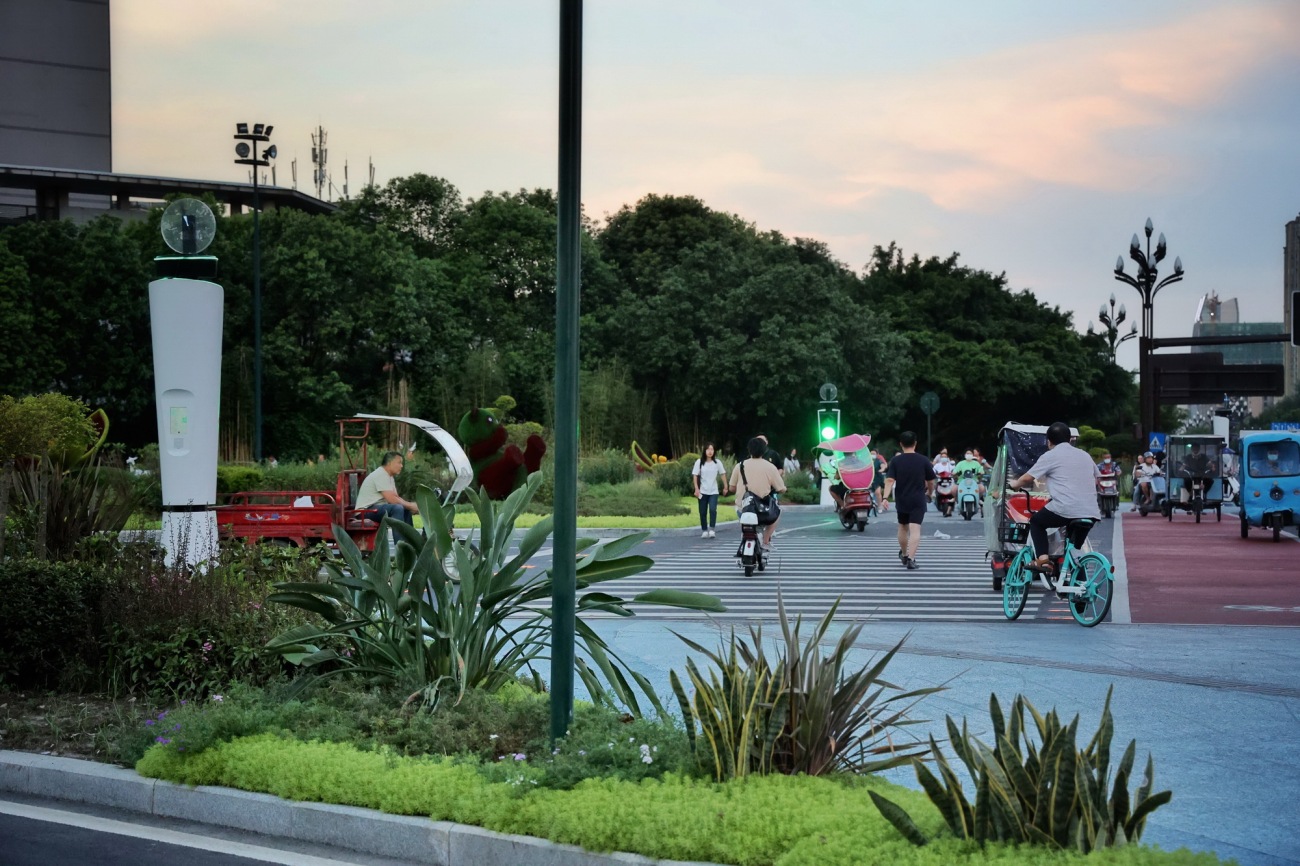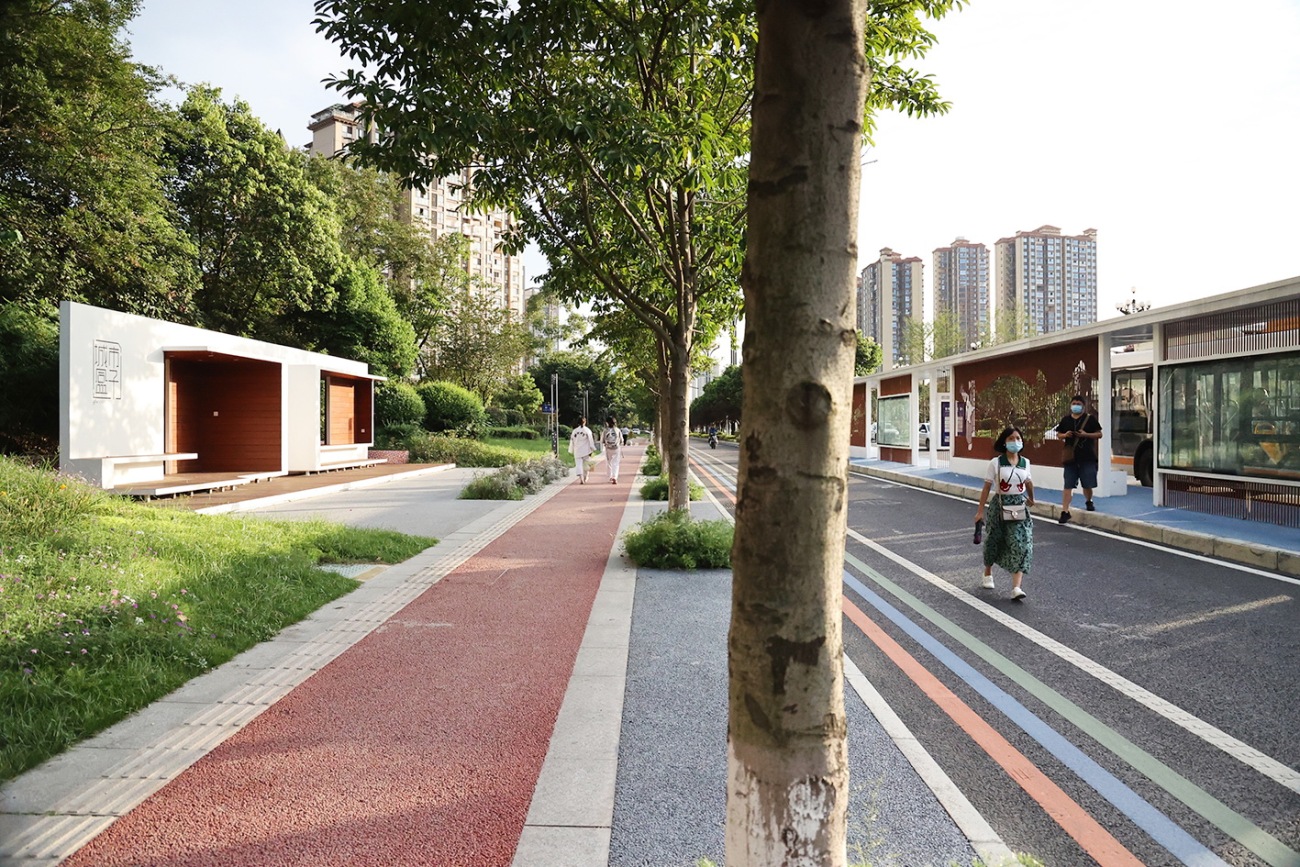一、背景:Background
街道,是城市最基本的公共设施,是城市居民关系最为密切的活动场所,也是城市历史、文化的重要空间载体。平坦的地形、舒适的气候和休闲的性格特质,早就催生了成都人爱“逛街”的生活习惯。据成都市综合交通调查,全市非通勤出行比例高达56%,居民出行比例中慢行比例达47.5%。
Streets are the most fundamental public facilities in cities, the places where urban residents have the closest relationships, and also important spatial carriers of urban history and culture. The flat terrain, comfortable climate, and leisurely character traits have long fostered the lifestyle of Chengdu people who love "window shopping". According to the comprehensive transportation survey of Chengdu City, the proportion of non-commuting trips in the city is as high as 56%, and the proportion of slow travel in the residents' travel accounts for 47.5%.
与此同时,街道更是美丽宜居公园城市建设理念的具体落实和生动表达。为全面落实新发展理念,营造公园城市美丽宜人的特色街区场景,成都市出台了《成都市公园城市街道一体化设计导则》(以下简称《导则》)等相应文件,为公园城市街区规划建设提供上位支撑。
At the same time, streets are also the specific implementation and vivid expression of the concept of building a beautiful and livable park city. To fully implement the new development concept and create beautiful and pleasant characteristic block scenes of the park city, Chengdu City has introduced the "Chengdu Park City Street Integrated Design Guidelines" (hereinafter referred to as the "Guidelines") and other corresponding documents, providing top-level support for the planning and construction of park city blocks.
《导则》明确了一体化设计的红线范围,由以往的道路红线以内拓宽到了以街道为中心的U型空间,大大拓展了“街道空间”的范畴。
The "Guidelines" clearly define the scope of integrated design, expanding from the road red line in the past to the U-shaped space centered on the street, greatly expanding the category of "street space".
二、蜀龙大道 The Shulong Avenue
区位与契机Location and Opportunity
本次设计改造的蜀龙大道位于新都区内,南起熊猫大道,与成都绕城高速、新都绕城大道、兴城大道、马超路、新北大道等相交,北至鸿运大道,是成都市区域级交通主干路,承载着新都城区以及与成都市区之间的主要联系。全长约12.6km,一体化设计红线范围约为25万平方米。
The Shu Long Avenue, which is the subject of this design renovation, is located within the Xindu District. It starts from the Panda Avenue in the south, intersects with Chengdu Ring Expressway, Xindu Ring Road, Xingcheng Avenue, Ma Chao Road, Xinbei Avenue, etc., and extends to the Hongyun Avenue in the north. It is a major regional traffic artery in Chengdu City, bearing the main connection between the Xindu urban area and the urban area of Chengdu. The total length is approximately 12.6 kilometers, and the scope of the integrated design red line is about 250,000 square meters.
蜀龙大道于2005年建成通车,投运十多年以来,沿线发展迅速,车行交通量巨大,与此同时,全线无贯通的慢行系统,市政配套设施老旧,道路现状的实际情况已经无法满足目前各方面需求。
The Shu Long Avenue was completed and opened to traffic in 2005. Over more than a decade since its operation, the area along the road has developed rapidly, with a huge volume of vehicular traffic. At the same time, there is no continuous slow traffic system along the line, and the municipal supporting facilities are old, making the current road conditions unable to meet the current needs in various aspects.
再加上即将到来的世界大学生运动会重要场馆分布于蜀龙大道周边,也推动了其改造工程的启动。
在公园城市街道一体化建设的背景下,蜀龙大道将通过车行空间与慢行空间的全方位改造,来满足公园城市背景下的新型道路公共空间。其中市政专业由中国市政西南院完成,景观部分由元有负责。
In addition, the upcoming World University Games, with important venues distributed around Shu Long Avenue, has also promoted the start of its renovation project.
Under the background of the integrated construction of the park city streets, Shu Long Avenue will undergo a comprehensive transformation of both vehicular and slow traffic spaces to meet the new type of road public space in the context of the park city. Among them, the municipal professional part is completed by the Southwest Municipal Engineering Research Institute of China, and the landscape part is undertaken by yǒuscape .
▽蜀龙大道改造前Before the renovation of Shulong Avenue
调研与策略Research and Strategy
对于改造项目,充分了解场地现状是设计的前提。而本项目线型的道路空间两侧复杂多变的城市用地界面,以及大量的现状植被使得现场踏勘的难度大大增加。
For renovation projects, a thorough understanding of the current site conditions is a prerequisite for design. The complex and variable urban land use interfaces on both sides of the linear road space of this project, along with a large amount of existing vegetation, greatly increase the difficulty of on-site surveys.
我们对项目进行了全线勘查,项目组成员分组分段用了为期一周的时间,对12.6km的场地范围进行了地毯式的摸排,最终明确了实际可用的改造边界,场地高差以及乔木点位等现状场地信息。并对调研结果进行了整理与归纳,为下一步改造方案的落地性提供了有效支撑。
We conducted a comprehensive survey of the entire project. The team members divided into groups and spent a week on a section-by-section inspection of the 12.6km site range, conducting a thorough combing to clarify the actual available boundaries for transformation, site elevation differences, and the locations of large trees, among other current site information. The research findings were then organized and summarized, providing effective support for the feasibility of the next step in the renovation plan.
我们将场地可改造空间总体划分为通行空间改造与停留空间改造两个部分。
通行空间指沿车行道线型两侧的人行步道空间的改造与优化。这一部分我们通过场地空间尺度、场地内现状人行步道材质、场地内现状乔木点位三个要素,将场地归纳为十二类不同的现状情况,并以一体化改造策略为原则,通过增设绿化隔离、更换透水铺装、梳理现状种植、完善基础设施的策略为每一类空间提出相应的改造方案。
The design divides the reconfigurable space into two parts: the passage space and the stay space.
The passage space refers to the transformation and optimization of the pedestrian walkway space along the sides of the vehicular road. For this part, we categorized the site into twelve different current situations based on three elements: the spatial scale of the site, the material of the existing pedestrian walkways, and the locations of the existing large trees. With the principle of integrated transformation strategy, we proposed corresponding transformation plans for each type of space through strategies such as adding green barriers, replacing permeable paving, organizing the existing planting, and improving infrastructure.
▽道路通行空间改造策略图Road Traffic Space Renovation Strategy Map
通过空间的改造让自行车、电瓶车和人行各得其所,解决了慢行交通全线串联的需求,极大地提升了道路风貌和使用体验,成为了周边市民绿色出行、散步健身的线型公共空间。
Through the transformation of the space, we ensure that bicycles, electric scooters, and pedestrians each have their designated areas, addressing the need for a continuous slow traffic network. This greatly enhances the road's appearance and user experience, turning it into a linear public space for green travel, walking, and fitness for the surrounding residents.
▽焕然一新、功能复合的非机动车通过空间A refreshed and multifunctional space for non motorized vehicles to pass through
停留空间大多位于十字路口的转角处,这些街角往往都有大块的绿化用地,但完全没有被有效利用,我们将这些消极用地纳入了改造范围,将其打造成可供市民停留休憩的积极空间,而这,正是对《导则》中“以人为本”的落实与践行。
▽转角节点改造策略图
我们通过植被密度、地形高差与铺装材质三个要素对可改造的转角空间进行了归纳分类,并通过增设停留空间、梳理软景种植、补充小品设施三个方面的改造,为场地增加了28个街边转角口袋公园。
Most of the remaining space is located at the corner of the intersection, which often has large green land, but is completely not used effectively. The design incorporates these passive land into the transformation scope, and transforms it into a positive space for residents to stay and rest. The design adds 28 corner pocket parks for the site through the transformation of three aspects of adding stay space, combing soft landscape planting and supplementing sketch facilities.
▽转角停留空间模型Corner stay space model©yǒuscape
周边的市民在改造后的口袋公园中或停留交谈、或观景玩耍,甚至还自发地组织了唱歌演奏活动,原来无人问津的停留空间通过改造,成为了一个个展示市民风貌的城市舞台。
In the renovated pocket park, the surrounding citizens either stayed to talk, or play with the scenery, and even organized singing and playing activities spontaneously. These once-neglected stay spaces have been transformed into vibrant urban stages not only beautifies the city but also enriches the lives of its residents, creating a more cohesive and vibrant community.
▽建成后的街角口袋公园 Street corner pocket park
重要节点Key Node
车行环岛改造——“新都之心”Traffic Roundabout Transformation - "Heart of Xindu"
由于新都城市建设的发展,处于蜀龙大道与新都大道交叉处的环岛转盘作为新都区的交通地标,周边先后建成了苏宁商城、西南石油大学及多个住宅商业区,人流集散密度大大增加。现状转盘的交通组织形式已经无法满足车行与慢行之间的通勤功能需求。根据多轮改造方案推演,最终确定选择改建信号控制结合渠化岛的交通组织方式,优化场地的交通通行效率。随着车行交通组织的变化,道路交通岛以及四角的景观空间也一并得以提升。
With the development of Xindu's urban construction, the roundabout at the intersection of Shu Long Avenue and Xindu Avenue, as a traffic landmark of the Xindu District, has seen the construction of Suning Mall, Southwest Petroleum University, and multiple residential and commercial areas around it, significantly increasing the density of pedestrian flow. The current traffic organization form of the roundabout can no longer meet the commuting function needs between vehicular and slow traffic. After several rounds of transformation plan simulations, it was finally decided to choose the traffic organization method that combines signal control with channelized islands to optimize the traffic efficiency of the site. With the change in vehicular traffic organization, the road traffic islands and the landscape spaces at the four corners are also improved.
▽新都之心环岛改造前后Befor and After " Heart of Xindu" Transformation
▽通过交通岛和智能辅助设施的设置,加强了行人通过路口的便捷性和安全性By setting up transportation islands and intelligent auxiliary facilities, the convenience and safety of pedestrians passing through intersections have been strengthened
▽“新都之心”绿岛与街角绿地的花境green Island of“Heart of Xindu” and the green space on the corner
休憩空间——“城市盒子”Rest Space -- "Urban Box"
除了路口转角的节点,在狭长的路线中仍需要大量停留空间,我们植入了命名为“城市盒子”(yǒuspace)的构筑物,能够灵活地适配不同尺度的场地,也能通过单元组合提供多样化的休憩功能,还能为街道提供统一美观的立面形象。
我们首先用单面墙体取代传统廊架的点状支撑方式,减小了构筑的占地空间,使其在狭长的空间中可以根据需求灵活摆放;与此同时,我们将满足不同功能需求的独立盒状空间镶嵌在墙体上,在立面上与周边现状乔木一同形成了虚实相映的景观效果。
In addition to the nodes at the corners of intersections, there is still a need for a large number of resting spaces along the narrow routes. We have introduced structures named "Urban Box" (yǒuspace), which can flexibly adapt to different scales of sites and also provide a variety of resting functions through unit combinations. Moreover, they can offer a unified and aesthetic facade image to the streets.
We first replaced the traditional point support method of the corridor frame with a single-sided wall, reducing the space occupied by the structure and allowing it to be flexibly placed according to needs in the narrow space. At the same time, we embedded independent box-shaped spaces that meet different functional needs on the wall, forming a landscape effect of interplay between virtual and real on the facade together with the surrounding existing trees.
▽城市盒子设计图Design drawing of "Urban Box"
 |  |  |
▽白天和夜晚的城市盒子 Day and night of "Urban Box"
特色公交站——“前站后台”Featured Bus Station -- "Front Station and Back Stage"
蜀龙大道是城市主干道,这条路上的公交线路也是市民出行的重要途径,所以公交站台作为慢行交通与公共车行的转换空间,也是本次改造的重要内容。
对此,我们从空间优化与形象展示两个方面作为切入点,现状公交站台处于车行辅道与主道之间的侧分绿化带上,进深2米不到,等候空间局促且前后都与车行道相邻,毫无遮拦,导致人们候车时缺乏安全感和舒适感,每逢高峰时段,甚至还会出现人群被迫在车行道上候车的情形。
The Shulong Avenue is a major city artery, and the bus routes on this road are also an important means of travel for citizens. Therefore, the bus stops, as the transition space between slow-moving traffic and public transport, are also an important part of this renovation.
In this regard, we take the optimization of space and the display of image as the entry points. The current bus stops are located on the side dividing green belt between the auxiliary road and the main road, with a depth of less than 2 meters. The waiting space is cramped, and both the front and back are adjacent to the traffic lanes, with no shelter, which makes people feel insecure and uncomfortable while waiting for the bus. During peak hours, people are even forced to wait on the traffic lanes.
我们首先将站台的上车区和等候区分离,在站台后侧绿地中借由“城市盒子”来提供休憩等候的功能,并嵌入智能显示屏,让人可以随时关注公交班次和到达时间,做到毫不慌张地惬意等候,当自己要乘坐的车辆即将到站时,再来到前站区域排队上车。这种“前站后台”的候车空间布局,既提升了候车体验,同时也减少了占道候车的安全隐患。
First,we separate the boarding area and the waiting area of the platform. By utilizing the "Urban Box" in the green space behind the platform, we provide a resting and waiting function, and embed a smart display screen, allowing people to always pay attention to the bus schedule and arrival time, and wait comfortably without panic. When the bus they are going to take is about to arrive, they can then go to the front area to line up and get on the bus. This "front station and back stage" layout of the waiting space not only improves the waiting experience but also reduces the safety hazards of occupying the road for waiting.
▽前站后台策略图Strategy diagramof "Front Station and Back Station"
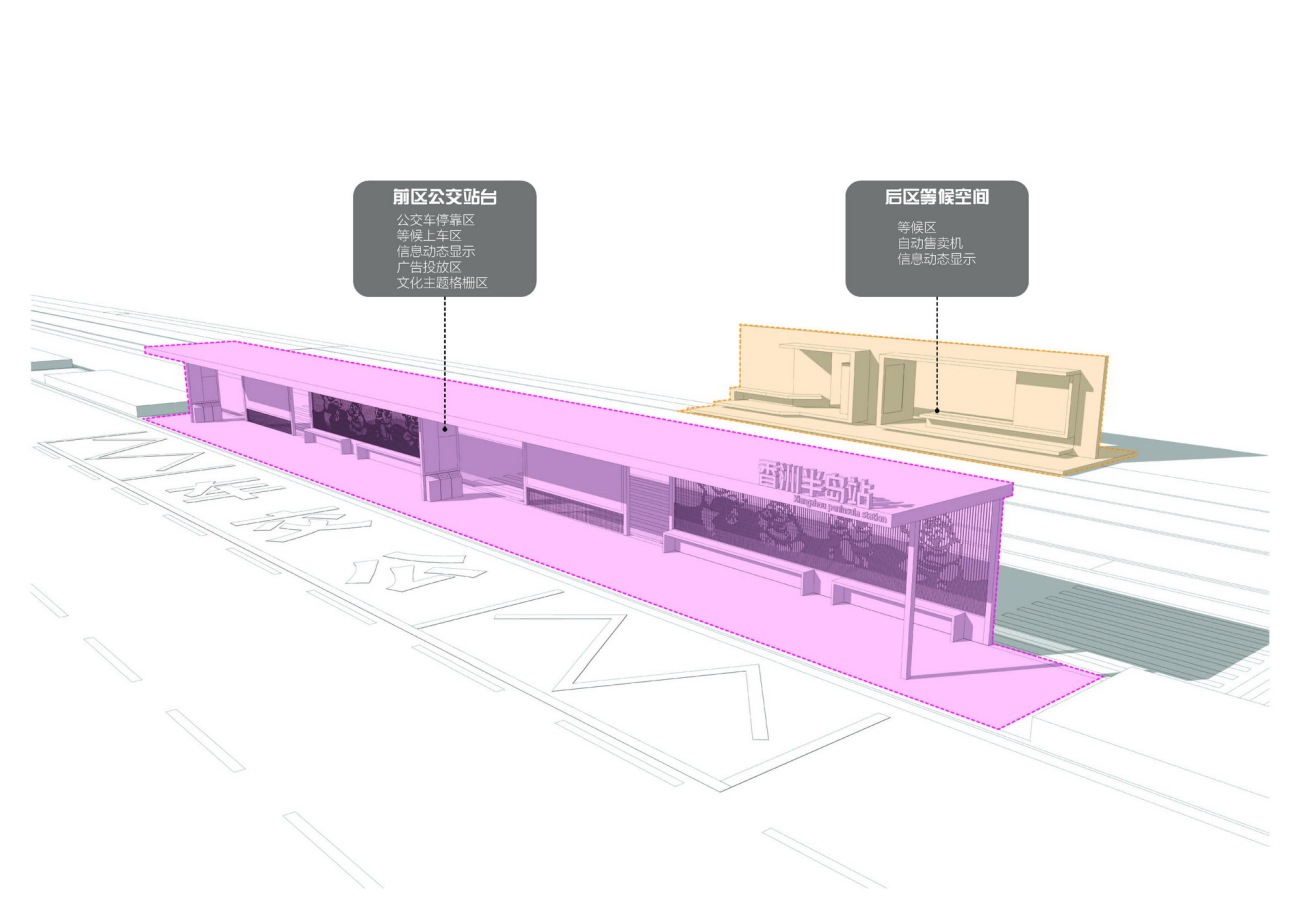 | 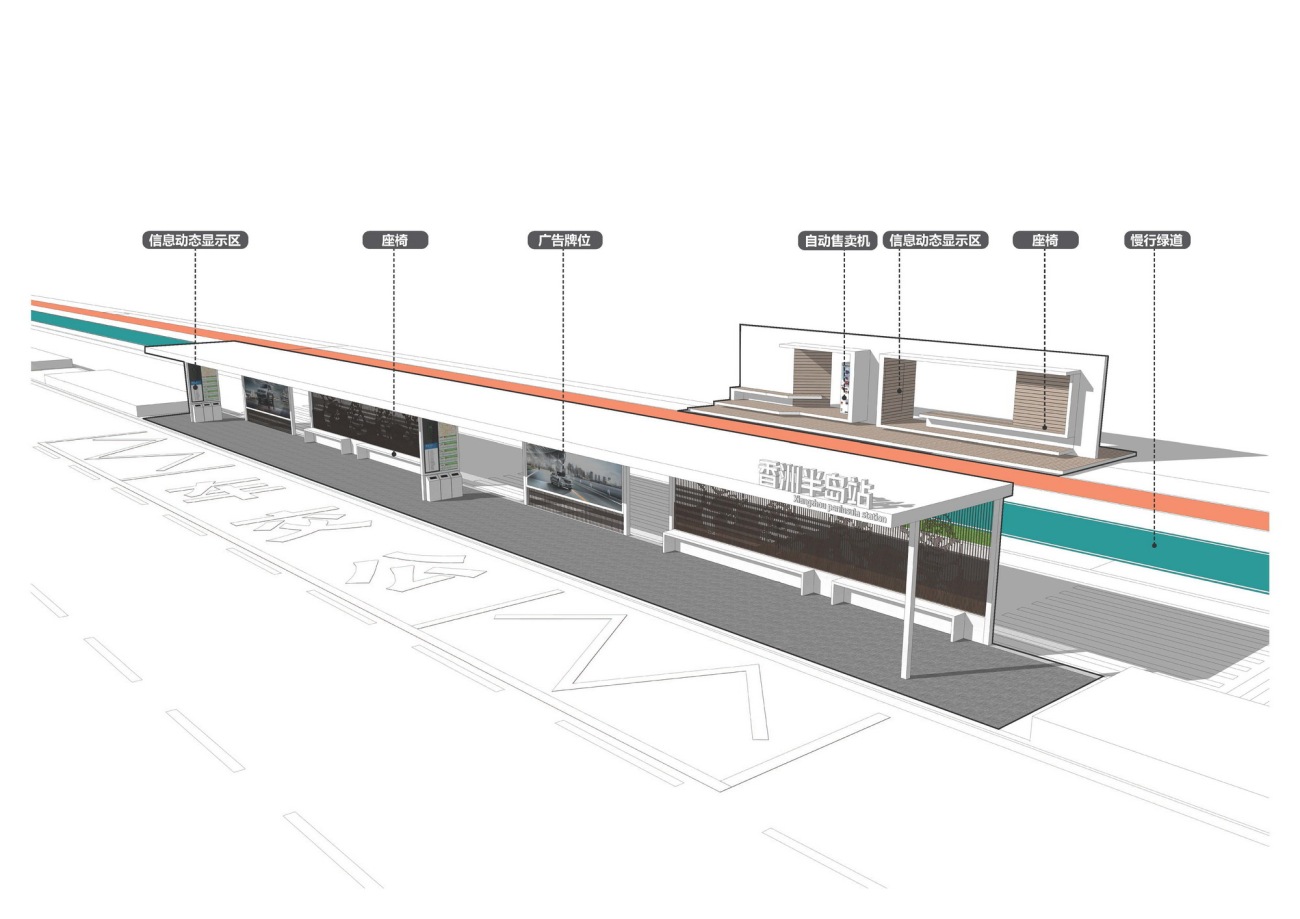 |  |
在功能空间优化的基础上,我们对公交站亭与等候区廊架进行了景观化设计,摒弃传统千篇一律的成品公交站亭方案,在满足功能的同时,植入了地域文化元素与一系列智能化设备,使其成为道路沿线让人眼前一亮的城市雕塑。
On the foundation of enhancing functional spaces, we have undertaken a landscape design for the bus shelter pavilions and the waiting area colonnades, moving away from the conventional, monotonous ready-made bus stop pavilion solutions. In addition to fulfilling the necessary functions, we have incorporated local cultural elements and an array of intelligent equipment, transforming them into urban sculptures that catch the eye along the thoroughfare.
▽“前站后台”特色公交站Featured Bus Station -- "Front Station and Back Stage"
三、媒体报道与使用者评价 Media reports and user evaluations
本地媒体“成都向上”在《成都二圈层公交站大PK:龙泉双流一言难尽,新都居然赢了?》一文里,特意提到蜀龙大道沿线的公交站,给予了挺高的评价,来自媒体和使用者的反馈如下:
Local media "UPchengdu" specifically mentioned the bus stops along Shulong Avenue in their article "A Big Comparison of Bus Stops in the Second Ring Road of Chengdu: Longquan and Shuangliu are Hard to Describe, but Xindu Surprisingly Wins?". The feedback from the media and users is as follows:
▽百姓“以为是效果图”的站台非美颜照Pictures that people think are renderings
四、结语Conclusion
《伟大的街道》一书描述了一条好的街道理想中的样子:它应该“作为城市的亮点与骄傲”,应当“能促进人们的交谊与互动”、应当“保障公共空间的舒适和安全”、应当“给人们留下深刻的印象”。《成都市公园城市街道一体化设计导则》的提出,可以看出在公园城市建设的背景下,对于街道的规划在从以车行为主向“以人为本”、慢行优先的建设思路转变。
街道一体化改造模式,作为对传统市政道路项目的一种突破,由于法律法规不完善、用地权属不明确等客观问题,我们在过程中也遇到了很多困难和遗憾,同时也收获积累了宝贵的经验与心得。正如元有一贯秉持的愿景“为人创造可持续的公共环境”,我们非常有幸可以亲身经历并参与到这一城市建设转变的过程中,一起创造与见证公园城市带来的美好。
The book "The Great Streets" outlines the ideal characteristics of a fine street: it should "act as a focal point and source of pride for the city," it should "facilitate social interaction and communication among citizens," it should "guarantee the comfort and security of public spaces," and it should "make a lasting impression on individuals." The introduction of "Chengdu's Park City Street Integrated Design Guidelines" reflects a shift in street planning, from a vehicle-centric approach to one that prioritises "people-first" and slow-traffic principles, within the context of park city development.
The integrated street renovation model, a departure from traditional municipal road projects, has faced numerous challenges and regrets due to issues such as incomplete legal frameworks and ambiguous land ownership rights. Despite these, the process has yielded invaluable experience and insights. Echoing the consistent vision of Yuan to "create sustainable public environments for people," we feel privileged to have been part of this urban transformation, contributing to and witnessing the splendour that the park city brings.
项目名称:蜀龙大道公园城市街道一体化改造(景观设计)
项目类型:景观设计
设计方:元有(成都)规划设计有限公司
公司网站::#小程序://元有景观/AQJYQFkfavFcfZy (请在手机端打开)
联系邮箱:3830744@qq.com
项目设计:2019-2020
完成年份:2021
设计团队:元有(成都)规划设计有限公司 / 方案:蒋侃迅、朱俊安、郝阳、刘赛君、李旺;施工图:胡偲佶、谢圣洋、姚俊华、邱晓冬
项目地址:四川省成都市新都区
项目面积:道路长度12.6km,一体化设计红线范围约25万平方米
合作单位:中国市政工程西南设计研究总院第九院(市政专业)
施工单位:北京市政建设集团有限责任公司
客户:成都市新都区兴城建设投资有限公司
摄影版权:元有团队自摄
Project name: Streetscape Design of Shulong Avenue(Landscape Design)
Project type: Landscape Design
Design: yǒu Landscape Architecture Design Ltd., Co.
Website: #小程序://元有景观/AQJYQFkfavFcfZy (Please open on mobile devices)
Contact e-mail: 3830744@qq.com
Design year: 2019-2020
Completion Year: 2021
Leader designer & Team: yǒu Landscape Architecture Design Ltd., Co./ Concept: Jiang Kanxun, Zhu Jun'an, Hao Yang, Liu Saijun, Li Wang; Construction Drawings: Hu Sijie, Xie Shengyang, Yao Junhua, Qiu Xiaodong
Project location: Chengdu, Sichuan Province
Gross built area:Road length of 12.6 km, integrated design red line area of approximately 250,000 square meters
Partner:Municipal Engineering: The Ninth Institute·Southwest China Municipal Engineering Design and Research Institute;
Construction Company: Beijing Municipal Engineering Construction Group Co., Ltd.
Clients:Chengdu Xindu District Xingcheng Construction Investment Co., Ltd.
Photo credit: Self-photographed by yǒu Team
更新日期:2024-08-08 15:20:10
非常感谢 元有景观 带来的精彩项目, 查阅更多Appreciations towards Meta landscape for sharing wonderful work on hhlloo. Click to see more works!
